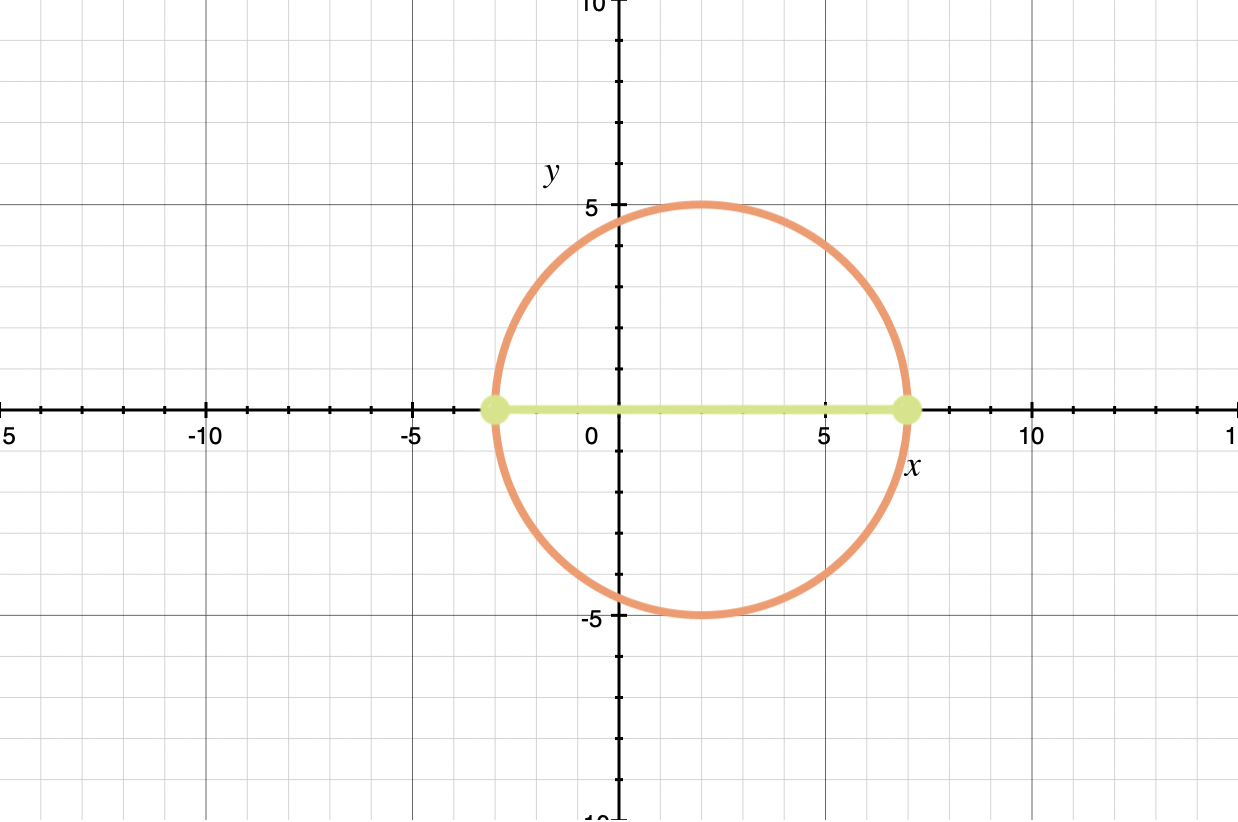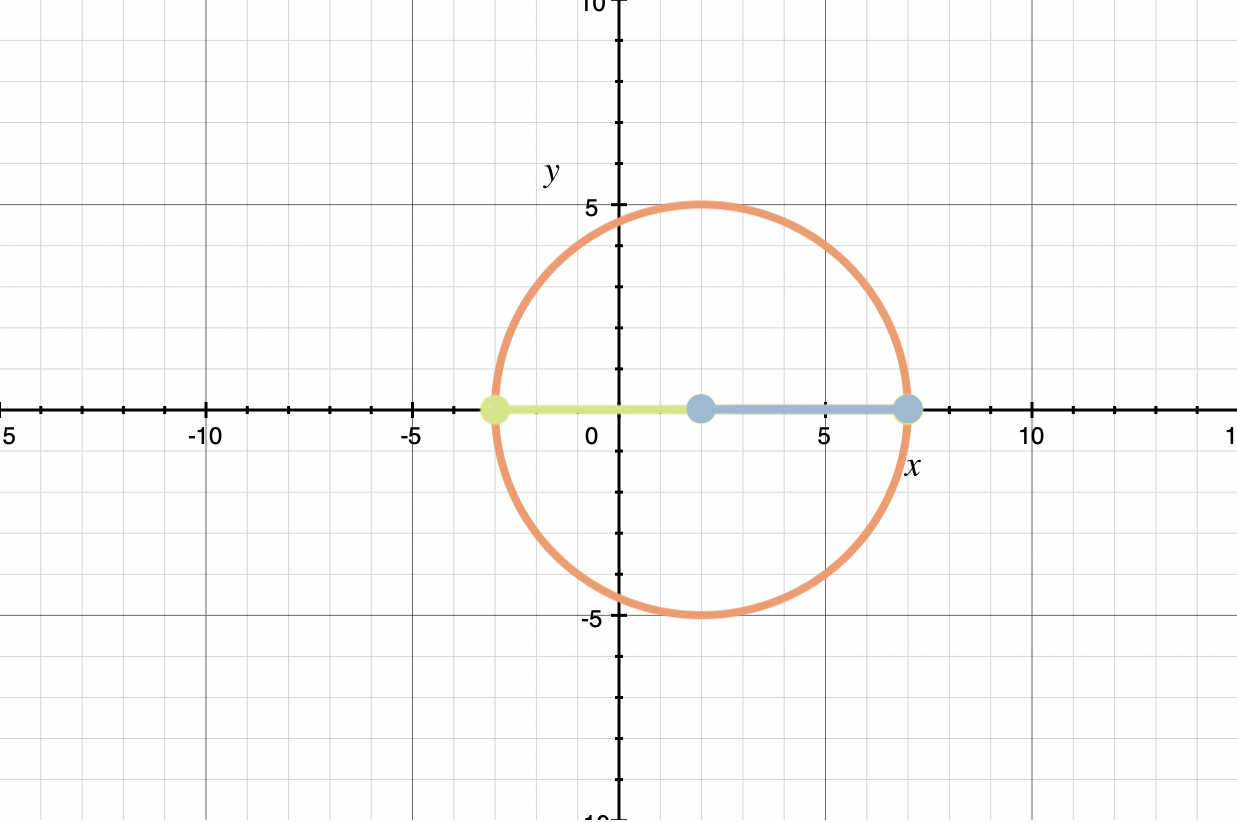Finding the radius and interval of convergence of a power series
What are the radius and interval of convergence of a series?
The interval of convergence of a series is the set of values for which the series is converging. Remember, even if we can find an interval of convergence for a series, it doesn’t mean that the entire series is converging, only that the series is converging in the specific interval.
The radius of convergence of a series is always half of the interval of convergence. You can remember this if you think about the interval of convergence as the diameter of a circle.
Hi! I'm krista.
I create online courses to help you rock your math class. Read more.
For example, imagine that the interval of convergence of a series is ???-3<x<7???. If we graph the interval of convergence along the ???x???-axis and then draw a circle where the endpoints of the interval lie along the circle’s perimeter, we get the following picture.
If the interval of convergence is represented by the orange diameter, then the radius of convergence will be half of the diameter.
With this in mind, we can state the universal fact that, given an interval of convergence
???a<x<b???
the radius of convergence is
???R=\frac{b-a}{2}???
To find the radius and interval of convergence of a given series, we’ll use the ratio test, which tell us that
If ???L=\lim_{n\to\infty}\left|\frac{a_{n+1}}{a_n}\right|???, then
the series converges absolutely if ???L<1???.
the series diverges if ???L>1??? or if ???L??? is infinite.
the test is inconclusive if ???L=1???.
Since we know that the series converges when ???L<1???, we can find ???L???, set it ???L<1???, and then find the values for which the series converges.
The radius of convergence ???R??? of the series will be given by ???|x-a|<R???.
The interval of convergence will be given by ???a-R<x<R+a???.
Once we have the interval of convergence, we’ll need to check the convergence of the endpoints of the interval by plugging the endpoints into the original series and using any convergence test that we can to say whether or not the series converges at the endpoint.
If the series diverges at both endpoints, the interval of convergence is ???a-R<x<R+a???.
If the series diverges at the left endpoint and converges at the right endpoint, the interval of convergence is ???a-R<x\leq R+a???.
If the series diverges at the right endpoint and converges at the left endpoint, the interval of convergence is ???a-R\leq x<R+a???.
How to calculate the radius and interval of convergence
Take the course
Want to learn more about Calculus 2? I have a step-by-step course for that. :)
Another example of finding the radius of convergence and interval of convergence of a power series
Example
Find the radius and interval of convergence of the series.
???\sum^{\infty}_{n=1}\frac{(-1)^nn(x-4)^n}{3^n}???
Our series is
???a_n=\frac{(-1)^nn(x-4)^n}{3^n}???
To generate ???a_{n+1}???, we’ll replace ???n??? with ???n+1???, and get
???a_{n+1}=\frac{(-1)^{n+1}(n+1)(x-4)^{n+1}}{3^{n+1}}???
Now we can plug ???a_n??? and ???a_{n+1}??? into
???L=\lim_{n\to\infty}\left|\frac{a_{n+1}}{a_n}\right|???
and use the ratio test to find the radius of convergence.
???L=\lim_{n\to\infty}\left|\frac{\frac{(-1)^{n+1}(n+1)(x-4)^{n+1}}{3^{n+1}}}{\frac{(-1)^nn(x-4)^n}{3^n}}\right|???
???L=\lim_{n\to\infty}\left|\frac{(-1)^{n+1}(n+1)(x-4)^{n+1}}{3^{n+1}}\cdot\frac{3^n}{(-1)^nn(x-4)^n}\right|???
???L=\lim_{n\to\infty}\left|\frac{(-1)^{n+1}}{(-1)^n}\cdot\frac{(n+1)}{n}\cdot\frac{(x-4)^{n+1}}{(x-4)^n}\cdot\frac{3^n}{3^{n+1}}\right|???
???L=\lim_{n\to\infty}\left|(-1)^{n+1-n}\cdot\frac{n+1}{n}\cdot(x-4)^{n+1-n}\cdot\frac{1}{3^{n+1-n}}\right|???
???L=\lim_{n\to\infty}\left|-\frac{n+1}{n}\cdot x-4\cdot\frac13\right|???
???L=\lim_{n\to\infty}\left|-\frac{(n+1)(x-4)}{3n}\right|???
Since we’re dealing with absolute value brackets, the ???-1??? can be dropped.
???L=\lim_{n\to\infty}\left|\frac{(n+1)(x-4)}{3n}\right|???
Since it contains no ???n??? terms and therefore won’t be effected by the limit, we can pull the ???x-4??? out in front, as long as we keep in inside absolute value brackets since there are some values of ???x??? for which ???x-4??? would be negative.
???L=|x-4|\lim_{n\to\infty}\left|\frac{n+1}{3n}\right|???
Because evaluating the limit at this point would result in the indeterminate form ???\infty/\infty???, we’ll need to manipulate our fraction.
???L=|x-4|\lim_{n\to\infty}\left|\frac{n+1}{3n}\left(\frac{\frac{1}{n}}{\frac{1}{n}}\right)\right|???
???L=|x-4|\lim_{n\to\infty}\left|\frac{\frac{n}{n}+\frac{1}{n}}{\frac{3n}{n}}\right|???
???L=|x-4|\lim_{n\to\infty}\left|\frac{1+\frac{1}{n}}{3}\right|???
Evaluate the limit.
???L=|x-4|\frac{1+\frac{1}{\infty}}{3}???
???L=|x-4|\frac{1+0}{3}???
???L=\frac13|x-4|???
The ratio test tells us that our series converges when ???L<1???, so we’ll set ???L<1??? and manipulate the inequality into the form ???|x-a|<R???, where ???R??? is the radius of convergence.
???\frac13|x-4|<1???
???|x-4|<3???
With the inequality in this form, we can say that the radius of convergence of our series is ???R=3???.
The radius of convergence of a series is always half of the interval of convergence.
To find the interval of convergence, we simply solve ???|x-4|<3??? for ???x???. To do this, we just take away the absolute value brackets and add ???-R??? to the left side of the inequality, like this:
???-3<x-4<3???
???-3+4<x-4+4<3+4???
???1<x<7???
Before we can say that this is the interval of convergence, we have to check the endpoints of the interval to see if the series converges at either or both of the endpoints. We can do this by plugging the endpoints back into the original series and then testing for convergence.
For ???x=1???:
???\sum^{\infty}_{n=1}\frac{(-1)^nn(1-4)^n}{3^n}???
???\sum^{\infty}_{n=1}\frac{(-1)^nn(-3)^n}{3^n}???
???\sum^{\infty}_{n=1}\frac{(-1)^nn(-1)^n(3)^n}{3^n}???
???\sum^{\infty}_{n=1}(-1)^{2n}n???
We know that any value of ???n??? will result in an even exponent on the ???-1??? term, since the exponent is ???2n???. So ???(-1)^{2n}=1??? for all values of ???n???. Therefore
???\sum^{\infty}_{n=1}(1)n???
???\sum^{\infty}_{n=1}n???
We can test this remaining series for convergence using the ???n???th term test (also called the zero test, or divergence test). We’ll say that the series is ???a_n=n???. Since
???\lim_{n\to\infty}a_n=\lim_{n\to\infty}n\neq0???
then the series diverges at ???x=1??? by the divergence test.
For ???x=7???:
???\sum^{\infty}_{n=1}\frac{(-1)^nn(7-4)^n}{3^n}???
???\sum^{\infty}_{n=1}\frac{(-1)^nn(3)^n}{3^n}???
???\sum^{\infty}_{n=1}(-1)^nn???
We can test this remaining series for convergence using the ???n???th term test (also called the zero test, or divergence test). We’ll say that the series is ???a_n=n???. Since
???\lim_{n\to\infty}a_n=\lim_{n\to\infty}(-1)^nn\neq0???
then the series diverges at ???x=7??? by the divergence test.
Since the series does not converge at either endpoint, the interval of convergence is ???1<x<7???.








